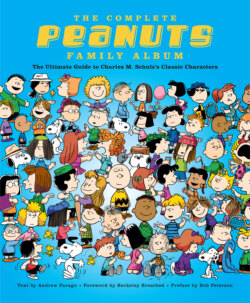Читать книгу The Complete Peanuts Family Album - Andrew Farago - Страница 8
На сайте Литреса книга снята с продажи.
ОглавлениеI
went as Charlie Brown for Halloween this past year.
At age fifty-six, I got a few sideways glances. My beard
and glasses with my Charlie Brown bald wig made me look
more like Sigmund Freud Charlie. But I didn’t care. The
whole universe of Peanuts characters that Schulz created is
sacred to me. I remember being in my pajamas as a four-
year-old watching the Christmas special when it first ran
on TV. I read every Peanuts book I could. I identified with
Charlie Brown’s insecurities. I was amazed at the secret,
adventurous world of Snoopy. I was inspired by the spiri-
tuality of Linus and that he could endure the fussbudgetry
of Lucy! I coughed on the sidewalk and then stomped on
the germs. Schulz’s work is in my artistic DNA now. He has
many lessons for us.
Peanuts is such an interesting mix of emotional angst
and surrealism. Somehow the two go together. Who among
us hasn’t felt that the world becomes surreal during times
of angst? I’ve taken that Schulzian idea into my cartooning
and animation career, which includes twenty-three years as
a story artist and screenwriter at Pixar.
In graduate school at Purdue University, I drew a
daily four-panel strip called Loco Motives for the Purdue
Exponent Newspaper. There, I was exploring the angst of
university life but overlaid with a surreal set of characters
including a herbivorous plains-dwelling antelope who just
happened to live with two dudes on campus. Blitzen, as I
called him, could talk, and his antlers (much like Snoopy’s)
could reshape and reflect his emotions. There was no
reason for putting this character in, but I was inspired by
how Snoopy’s surreal world of flying aces and bowling
alleys in his dog house paired nicely with a normal round-
headed boy who found the world mean and indecipherable.
This duality also inspired me on movies like Up, which
is a mix of the grief of Carl Fredriksen and the surrealism
of talking dogs (“Squirrel!”). The two balance and clarify
each other. It seemed like the lower we took Carl in grief,
the more outlandish we could go with Dug and the rest of
the dog pack. Carl’s grief stood out in stark contrast. His
character was clear.
Which is another Schulz lesson: clarity and contrast of
character—we all know what Lucy or Schroeder or Sally
would say or do in any situation. It’s what we in storytelling
grapple with, and I am daily inspired by Schulz’ mastery of
it. In Monsters, Inc., we spent a lot of time at the beginning
just trying to define how Mike Wazowski would contrast
Sulley. As an exercise, we put them in a situation of two
roommates picking out a tie for Sully to go out for the
evening. Mike fell into the role of the quick-tempered
smart aleck; Sulley was more clear-headed and controlled.
Each of the Peanuts characters had this—a clear personality
type. But it is when Schulz puts them in contrast with other
“side” characters that we get to see their depth. Linus’s
religious zealotry is put to the test in the Great Pumpkin
patch by Sally. The little red-haired girl, whom we never
see (a little red herring), brings out the romantic side in
Charlie Brown. Without her, we only see the insecure
Charlie. And on and on . . . Schulz created a world of
characters in which contrast of the side characters clarified
the main characters.
I am thankful every day that Schulz created this world
and left a legacy of lessons for storytellers, and now I’m
pondering next year’s costume.
Most of us familiar with Charles M. Schulz’s artwork recog-
nize it from the 17,897 Peanuts comic strips he wrote and
drew over his fifty-year career. And much of that artwork has
been used and modified in a variety of media for almost as
long, filtered through animation, commercial design, print,
and character licensing across the world. The artwork pre-
sented in The Complete Peanuts Family Album comes from
an array of sources and a diverse group of artists, including
designers from Peanuts Worldwide (PW) and Charles M.
Schulz Creative Associates (CSCA); some items come from
the archives of the Charles M. Schulz Museum (CMSM)
and some pieces have been specifically created for this book.
Regardless of the source, all of the artwork presented here is
lovingly inspired by Charles M. Schulz’s original work.
PREFACE
BY BOB PETERSON
opposite: Style Guide art – CSCA
11PREFACE
